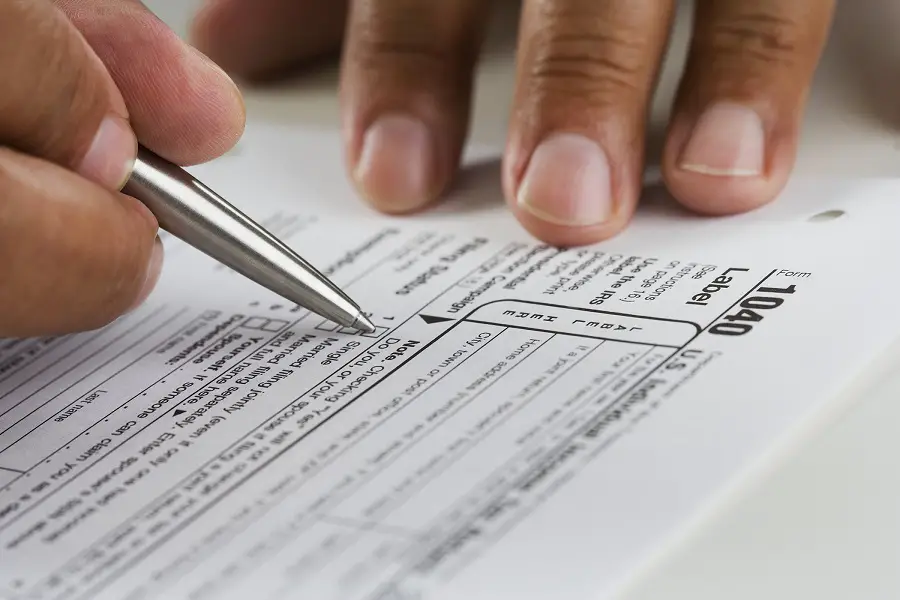This question is a bit complicated.
To answer it, you need to know what sort of taxes you’re paying.
The amount of time it takes is different for each type of tax.
For the average American filing the quick online form and claiming the standard deduction, filing taxes should be quick and easy. For others, it may seem like a smarter choice to have a professional handle your taxes for you instead.
Let’s take a look at filing taxes. We will go over the average times for varying types of filing and some strategies you can use to make it quick and easy for yourself when you file.
Contents
Time Saving Considerations

There are a few things that you can do to save yourself time when filing your taxes.
These don’t pertain directly to the filing, per se, and not all of them may apply to you, but they are important to consider if you want to save time when filing your taxes.
If you plan to have a professional do your taxes, these can save you money as well because when you are prepared and organized, they will spend less billable hours figuring everything out for you.
Store Your Documents Together

First, you need W2s to file.
Your employer should have these to you no later than the end of January. If they don’t, then they may owe you a penalty and you will need to contact them and the IRS.
If you work more than 1 job, then you will need to keep all of them in the same space so you don’t have to hunt them down when it’s time to file.
If you have other means of income, like stocks and dividends, you will need to keep track of these.
Make sure that you store them with your W2s, so you have all of your relevant materials together in the same place. You may have to look at the letter codes of box 12 to help you accurately file.
Keep Accurate Records

A lot of Americans these days take on “side hustles” like driving for Uber or PostMates.
These companies consider you an independent contractor and won’t take out taxes. You will need to keep a record of all your expenses and gains from these gigs.
If this is your first time filing this style of income, then it can feel very overwhelming and you may be hit with a huge bill if you didn’t set aside money to cover these taxes or file with your main job for more withdrawn from your paychecks than you need to.
Keeping accurate records will cut down on the time it takes to figure these taxes out, and determine what you owe.
When you know how much money you make from your side gigs and how much you’ve spent on the “business expenses” that aren’t compensated, you can make it very easy to determine what you owe.
This holds true for people who are self employed contractors and freelancers, too.
Remember to save your receipts from any working lunches or gas receipts driving to and from client meetings. If you rent a workspace from somewhere, be sure to include those as well.
The more accurate your records are, the more likely you are to have a smooth and quick filing process. The more scattered and incomplete your records, the more difficult it will be and thus, the more time it will require of you.
Know Your Bracket and Deductions
If you plan to claim a standard deduction, your taxes won’t take long at all.
If you’re going with a line item deduction rate, you will need to justify all of your deductions and keep receipts in case you get audited.
Knowing the things you plan to deduct, whether business expenses, stock losses, and charitable donations, and having those ready will also save you time.
Income

The first thing to look at is your income. This is, after all, what you’re going to be taxed each year.
There are different brackets that incomes fall into, and the most common misconception is that all of your income will be taxed at the highest bracket.
The way taxes work is on percentages. For example, each step of your income bracket gets taxed at that level.
So, no matter how much money you make each year, your first bit won’t be taxed. Let’s look at the tax rate chart to help you.
The 10% tax rate is for the first $9700 or $19,400 (depending on filing status) that you make.
The next bracket is for a higher level income, and so forth, until the highest bracket of 37% taxes incomes over $510,000 for single filing or $612,351 for married and joint filing.
The way it works is that each bracket taxes that amount. So, even for those in the 37% bracket, your income will be taxed in brackets. So, the first $9700 is taxed at 10%.
Then, the difference between that and $39,475 is taxed at 12%, not the entirety.
This continues, until, at the highest bracket, only what you make between $510,300 and the cap of your income is taxed at the highest rate. The rest has been taxed in the lower brackets.
Deductions

There are a couple of different types of deduction.
Each of them affects your tax rates, and one answer won’t be the best option for everyone.
For the average American, a standard deduction is more generous than a line item or adjustable deduction and saves a lot of time when filing.
Still, many others will find that this deduction is less generous than other options.
Above the Line Deductions

Above the line deductions are stand-alone adjustments. These are things that both standard and line item deductions can claim if they qualify.
These deductions include things like adjustments for educators who have paid out of their own income to furnish their classroom supplies.
Moving expenses for militia and new job assignments may qualify for these adjustments if you’re not compensated by new employers.
If you’ve been paying down student loans with, the interest they are charging you (and the amount of your payment that goes towards interest rates rather than the loan’s original debt) are also qualifying.
Any contribution you make to IRAs (Individual Retirement Accounts) also gets to be counted among your deductions.
From here, you need to determine whether you are claiming the standard deduction or a line item deduction method. Let’s take a look at the options.
Standard Deductions
The standard deduction is a fixed amount at a base level that the IRS will allow you to claim as a deduction if your itemized deductions don’t offer a better rate.
If you’ve got a simple tax filing with a single W2 and not very many holdings or special circumstances, then you can usually claim the standard deduction and benefit more from this than the other option.
The standard deduction for 2019 is $12,200 for single and separate filers, $18,350 for the head of household filers, $24,400 for married people filing jointly, and more if you are over 65 or blind.
This is more than the average American working a W2 job will have to claim through line item deductions in taxes. For people who are self-employed or have a lot of special circumstances or an incredibly high rate of charitable donations, this is not the best option.
Line Item Deductions (Itemized Deductions)

Itemized deductions can get a bit more complicated, but they offer additional tax breaks for those who itemize.
This solution foregoes the standard deduction in order to take the specific deductions instead.
Mortgage expenses are often considered in these deductions. Interest on loans and mortgage insurance premiums can be deducted from the income tax determination.
You can also deduct state and local taxes for real estate and personal property in some circumstances.
Charitable donations are also tax deductible. You are allowed to deduct the value of anything you donate – whether it’s toys, spare electronics, stocks, and cash.
Donations to churches also count.
You can deduct medical and dental expenses as well. Unreimbursed expenses above a certain percentage of your income are allowed.
There are a lot of other options, so if you choose this option then be sure to do your research.
This option takes a significantly longer time than claiming a standard deduction, and you will need to back up everything you claim with receipts and proof.
So how long does it take to do taxes?
On average, it takes Americans 13 hours to prepare their taxes.
This seems like a crazy amount of time but remember that this is an average for all Americans.
This means that it considers line item deductions, self employed people who have additional considerations, and high income people who need to prepare their records.
It includes those who haven’t kept great records and need to do some research to fill in gaps in their record keeping and other such circumstances.
If you are working W2 jobs and don’t have other revenue streams, and your deductions are better off with the standard deduction rate instead of the line items, you will find that it takes very little time to prepare your taxes.
This article contains a chart that further details how much you can expect to spend when it comes to your tax situation based on the form you will be filing.